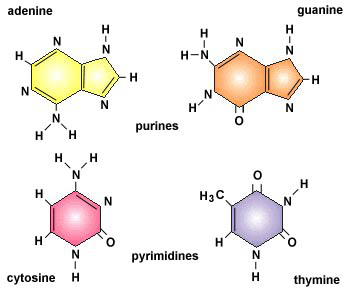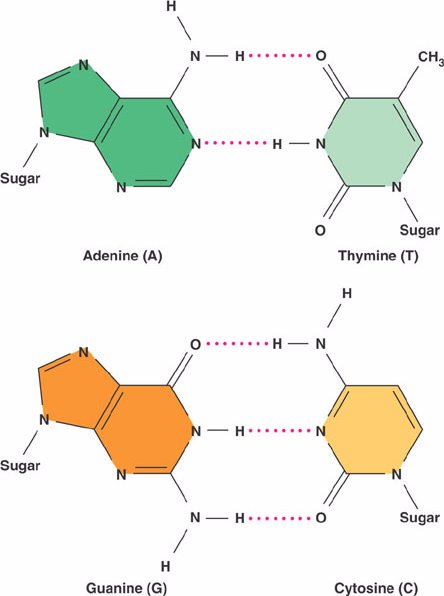Which Pair Of Nitrogenous Bases Will Form A Bond In A Dna Molecule? : You see, cytosine can form three hydrogen bonds with guanine, and adenine can form two hydrogen bonds with thymine.. This dna strand consists of eight pairs of nitrogenous bases. The compound formed by a nitrogenous base, purine or pyrimidine and aldopentose is four different types of nitrogenous bases are found in dna: The sequence of bases in a dna molecule contains the information that organisms need to build proteins and carry out many important life processes. A dna molecule has the shape of a double helix, or that of a twisted ladder. So each dna molecule is made up of two strands, and there are four nucleotides present in dna: Adenine bonds with thymine, and guanine bonds with cytosine. Which pair of nitrogenous bases will form a bond in a dna molecule? Adenine (a), thymine (t) the sequence of nucleotides in a dna sample can be determined by using the dideoxy. The two strands are held together by hydrogen bonds between the bases, with adenine forming a base pair with thymine, and cytosine forming a base pair with guanine. 06 (1 point) cytosine and adenine adenine and thymine o guanine and thymine thymine and cytosine 14 evidence suspect c evidence suspect d suspect b evidence suspect a evidence in hirt. Dna (deoxyribonucleic acid) is a molecule composed of two chains that coil around each other to form a double helix carrying genetic instructions for the development, functioning, growth and reproduction of all known organisms and many viruses. It allows something called complementary base pairing. The nitrogenous bases are (atgc). How to calculate number of base pairs in a dna fragment. How many different sequences of eight bases can you make? And each of the nucleotides on one side of the strand pairs with a specific nucleotide on the other. Each strand of the helix is a chain of nucleotides. The chemistry of the nitrogenous bases is really the key to the function of dna. The bases are the letters that spell out the genetic code. A, c, t, and g. Adenine (a), thymine (t) the sequence of nucleotides in a dna sample can be determined by using the dideoxy. It's these bonds that form between the complementary base sequence of the nitrogenous bases that hold together the two dna strands to form the. Dna is composed of two strands of nucleotides held together by hydrogen bonding. Dna is composed of two strands of nucleotides held together by hydrogen bonding. The two dna strands are also known as. How to calculate number of base pairs in a dna fragment. A, c, t, and g. Iii according to the gels. Deoxyribonucleic acid is a molecule composed of two polynucleotide chains that coil around each other to form a double helix carrying genetic instructions for the. The two strands are held together by hydrogen bonds between the nitrogenous bases of the. The nitrogenous bases are (atgc). Enzymes link together to form a template for a new dna molecule to be built. The two strands are held together by hydrogen bonds between the bases, with adenine forming a base pair with thymine, and cytosine forming a base pair with guanine. Base pair describes the relationship between the building blocks on the strands of dna. The bases are the letters that spell out the genetic code. Calculating possible combinations of bases in a dna strand of a given length. Hydrogen bonds form between the nitrogenous bases in a dna molecule. It allows something called complementary base pairing. Deoxyribonucleic acid, more commonly referred to as dna, is the primary genetic material for almost all life. The offspring of sexually reproducing organisms can be distinguished from the offspring of asexually reproducing organisms by studying which of the fo … llowing? Examine the structure of one nitrogenous base molecule by clicking on the button below (wait a few seconds for it to load in the space at right). A dna molecule has the shape of a double helix, or that of a twisted ladder. The bases are the letters that spell out the genetic code. A base pair refers to two bases which form a rung of the dna ladder. a dna nucleotide is made of a molecule of sugar, a molecule of phosphoric acid, and a molecule called a base. The nitrogenous bases are (atgc). Deoxyribonucleic acid, more commonly referred to as dna, is the primary genetic material for almost all life. The strands each run from 5' to 3' and run in antiparallel, or opposite, directions from one another. So each dna molecule is made up of two strands, and there are four nucleotides present in dna: Dna (deoxyribonucleic acid) is a molecule composed of two chains that coil around each other to form a double helix carrying genetic instructions for the development, functioning, growth and reproduction of all known organisms and many viruses. The chemistry of the nitrogenous bases is really the key to the function of dna. The four different bases pair together in a way known as complementary pairing. The bases are the letters that spell out the genetic code. Base pair describes the relationship between the building blocks on the strands of dna. An a base on one strand will always. It allows something called complementary base pairing. But, there can be millions and millions of base pairs. How many different sequences of eight bases can you make? Iii according to the gels. The molecule is asymmetrical is because the glycosidic bonds of a base pair are not diametrically opposite to each other.
The two dna strands are also known as.

The sequence of bases in a dna molecule contains the information that organisms need to build proteins and carry out many important life processes.
It's these bonds that form between the complementary base sequence of the nitrogenous bases that hold together the two dna strands to form the.
Which Pair Of Nitrogenous Bases Will Form A Bond In A Dna Molecule? : You see, cytosine can form three hydrogen bonds with guanine, and adenine can form two hydrogen bonds with thymine.. This dna strand consists of eight pairs of nitrogenous bases. The compound formed by a nitrogenous base, purine or pyrimidine and aldopentose is four different types of nitrogenous bases are found in dna: The sequence of bases in a dna molecule contains the information that organisms need to build proteins and carry out many important life processes. A dna molecule has the shape of a double helix, or that of a twisted ladder. So each dna molecule is made up of two strands, and there are four nucleotides present in dna:
Adenine bonds with thymine, and guanine bonds with cytosine. Which pair of nitrogenous bases will form a bond in a dna molecule? Adenine (a), thymine (t) the sequence of nucleotides in a dna sample can be determined by using the dideoxy. The two strands are held together by hydrogen bonds between the bases, with adenine forming a base pair with thymine, and cytosine forming a base pair with guanine. 06 (1 point) cytosine and adenine adenine and thymine o guanine and thymine thymine and cytosine 14 evidence suspect c evidence suspect d suspect b evidence suspect a evidence in hirt.

The two dna strands are also known as.
Dna (deoxyribonucleic acid) is a molecule composed of two chains that coil around each other to form a double helix carrying genetic instructions for the development, functioning, growth and reproduction of all known organisms and many viruses. It allows something called complementary base pairing. The nitrogenous bases are (atgc). How to calculate number of base pairs in a dna fragment. How many different sequences of eight bases can you make? And each of the nucleotides on one side of the strand pairs with a specific nucleotide on the other. Each strand of the helix is a chain of nucleotides. The chemistry of the nitrogenous bases is really the key to the function of dna. The bases are the letters that spell out the genetic code. A, c, t, and g. Adenine (a), thymine (t) the sequence of nucleotides in a dna sample can be determined by using the dideoxy. It's these bonds that form between the complementary base sequence of the nitrogenous bases that hold together the two dna strands to form the. Dna is composed of two strands of nucleotides held together by hydrogen bonding.
Dna is composed of two strands of nucleotides held together by hydrogen bonding. The two dna strands are also known as. How to calculate number of base pairs in a dna fragment. A, c, t, and g. Iii according to the gels.

The sequence of bases in a dna molecule contains the information that organisms need to build proteins and carry out many important life processes.
Deoxyribonucleic acid is a molecule composed of two polynucleotide chains that coil around each other to form a double helix carrying genetic instructions for the. The two strands are held together by hydrogen bonds between the nitrogenous bases of the. The nitrogenous bases are (atgc). Enzymes link together to form a template for a new dna molecule to be built. The two strands are held together by hydrogen bonds between the bases, with adenine forming a base pair with thymine, and cytosine forming a base pair with guanine. Base pair describes the relationship between the building blocks on the strands of dna. The bases are the letters that spell out the genetic code. Calculating possible combinations of bases in a dna strand of a given length. Hydrogen bonds form between the nitrogenous bases in a dna molecule. It allows something called complementary base pairing. Deoxyribonucleic acid, more commonly referred to as dna, is the primary genetic material for almost all life. The offspring of sexually reproducing organisms can be distinguished from the offspring of asexually reproducing organisms by studying which of the fo … llowing? Examine the structure of one nitrogenous base molecule by clicking on the button below (wait a few seconds for it to load in the space at right).
A dna molecule has the shape of a double helix, or that of a twisted ladder. The bases are the letters that spell out the genetic code. A base pair refers to two bases which form a rung of the dna ladder. a dna nucleotide is made of a molecule of sugar, a molecule of phosphoric acid, and a molecule called a base. The nitrogenous bases are (atgc). Deoxyribonucleic acid, more commonly referred to as dna, is the primary genetic material for almost all life.
It's these bonds that form between the complementary base sequence of the nitrogenous bases that hold together the two dna strands to form the.
The strands each run from 5' to 3' and run in antiparallel, or opposite, directions from one another. So each dna molecule is made up of two strands, and there are four nucleotides present in dna: Dna (deoxyribonucleic acid) is a molecule composed of two chains that coil around each other to form a double helix carrying genetic instructions for the development, functioning, growth and reproduction of all known organisms and many viruses. The chemistry of the nitrogenous bases is really the key to the function of dna. The four different bases pair together in a way known as complementary pairing. The bases are the letters that spell out the genetic code. Base pair describes the relationship between the building blocks on the strands of dna. An a base on one strand will always. It allows something called complementary base pairing. But, there can be millions and millions of base pairs. How many different sequences of eight bases can you make? Iii according to the gels. The molecule is asymmetrical is because the glycosidic bonds of a base pair are not diametrically opposite to each other.
0 comments:
Post a Comment